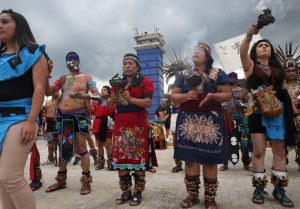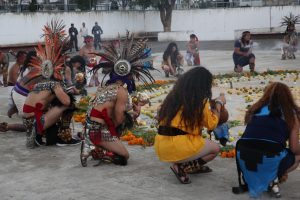 Mexico City, Oct 31 (EFE).- Inmates being held in four Mexico City prisons celebrated the Day of the Dead on Thursday with a pre-Hispanic dance, capital prison authorities reported.
Mexico City, Oct 31 (EFE).- Inmates being held in four Mexico City prisons celebrated the Day of the Dead on Thursday with a pre-Hispanic dance, capital prison authorities reported.
“Persons deprived of their liberty in Mexico City celebrated the ‘Day of the Dead’ or Micailhuitl with a pre-Hispanic dance at the Southern Men’s Preventive Prison,” the Penal System Undersecretariat for Mexico City said in a bulletin.
The undersecretary for the capital’s prison system, Hazael Ruiz Ortega, said that for the second consecutive year about 50 inmates from four prisons had participated in the event.
“The event of the pre-Hispanic dance was staged by 12 women from the Santa Martha Women’s Center and 38 men from the Eastern, Northern and Southern Men’s Preventive Prisons,” the capital’s government department said in its communique.
 The official commented that before starting the ceremony, all the participants, outfitted in their pre-Hispanic costumes, set up an altar in honor of Mictlantecuhtli, “the Lord of Mictlan” or the “Lord of the Place of the Dead,” around which the ceremony unfolded.
The official commented that before starting the ceremony, all the participants, outfitted in their pre-Hispanic costumes, set up an altar in honor of Mictlantecuhtli, “the Lord of Mictlan” or the “Lord of the Place of the Dead,” around which the ceremony unfolded.
The members of the four groups of inmates began by asking permission of the four cardinal directions to begin their dance as an offering emulating the ritual of adoration of the dead and for the spirits of the deceased to continue living in Mictlan, the underworld.
Ruiz Ortega mentioned the importance it represents to people deprived of their freedom to maintain their pride in Mexico’s pre-Hispanic origins and to be able to express themselves in accord with these same traditions.
The Day of the Dead has been celebrated in Mexico since before the arrival of the Spanish in the 16th century. In fact, it was a celebration common to all Mesoamerican cultures, which had a similar concept about death and its significance.
In these cultures, the fate of the dead was marked by the way they had lived their lives. With the arrival of the Spanish conquistadors, the festival became intertwined with Christian theology, acquiring new Catholic elements and significance, the cross of flowers being key among these elements.
